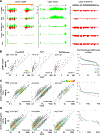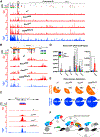Co-dependent Assembly of Drosophila piRNA Precursor Complexes and piRNA Cluster Heterochromatin
- PMID: 30257203
- PMCID: PMC6235161
- DOI: 10.1016/j.celrep.2018.08.081
Co-dependent Assembly of Drosophila piRNA Precursor Complexes and piRNA Cluster Heterochromatin
Abstract
In Drosophila, the piRNAs that guide germline transposon silencing are produced from heterochromatic clusters marked by the HP1 homolog Rhino. We show that Rhino promotes cluster transcript association with UAP56 and the THO complex, forming RNA-protein assemblies that are unique to piRNA precursors. UAP56 and THO are ubiquitous RNA-processing factors, and null alleles of uap56 and the THO subunit gene tho2 are lethal. However, uap56sz15 and mutations in the THO subunit genes thoc5 and thoc7 are viable but sterile and disrupt piRNA biogenesis. The uap56sz15 allele reduces UAP56 binding to THO, and the thoc5 and thoc7 mutations disrupt interactions among the remaining THO subunits and UAP56 binding to the core THO subunit Hpr1. These mutations also reduce Rhino binding to clusters and trigger Rhino binding to ectopic sites across the genome. Rhino thus promotes assembly of piRNA precursor complexes, and these complexes restrict Rhino at cluster heterochromatin.
Keywords: Drosophilia; heterochromatin; piRNA; transposon silencing.
Copyright © 2018 The Authors. Published by Elsevier Inc. All rights reserved.
Conflict of interest statement
DECLARATION OF INTERESTS
The authors declare no competing interests.
Figures




References
-
- Aravin AA, Hannon GJ, and Brennecke J (2007). The Piwi-piRNA pathway provides an adaptive defense in the transposon arms race. Science 318, 761–764. - PubMed
-
- Belancio VP, Hedges DJ, and Deininger P (2008). Mammalian non-LTR retrotransposons: for better or worse, in sickness and in health. Genome Res. 18, 343–358. - PubMed
-
- Brennecke J, Aravin AA, Stark A, Dus M, Kellis M, Sachidanandam R, and Hannon GJ (2007). Discrete small RNA-generating loci as master regulators of transposon activity in Drosophila. Cell 128, 1089–1103. - PubMed
Publication types
MeSH terms
Substances
Grants and funding
LinkOut - more resources
Full Text Sources
Other Literature Sources
Molecular Biology Databases

